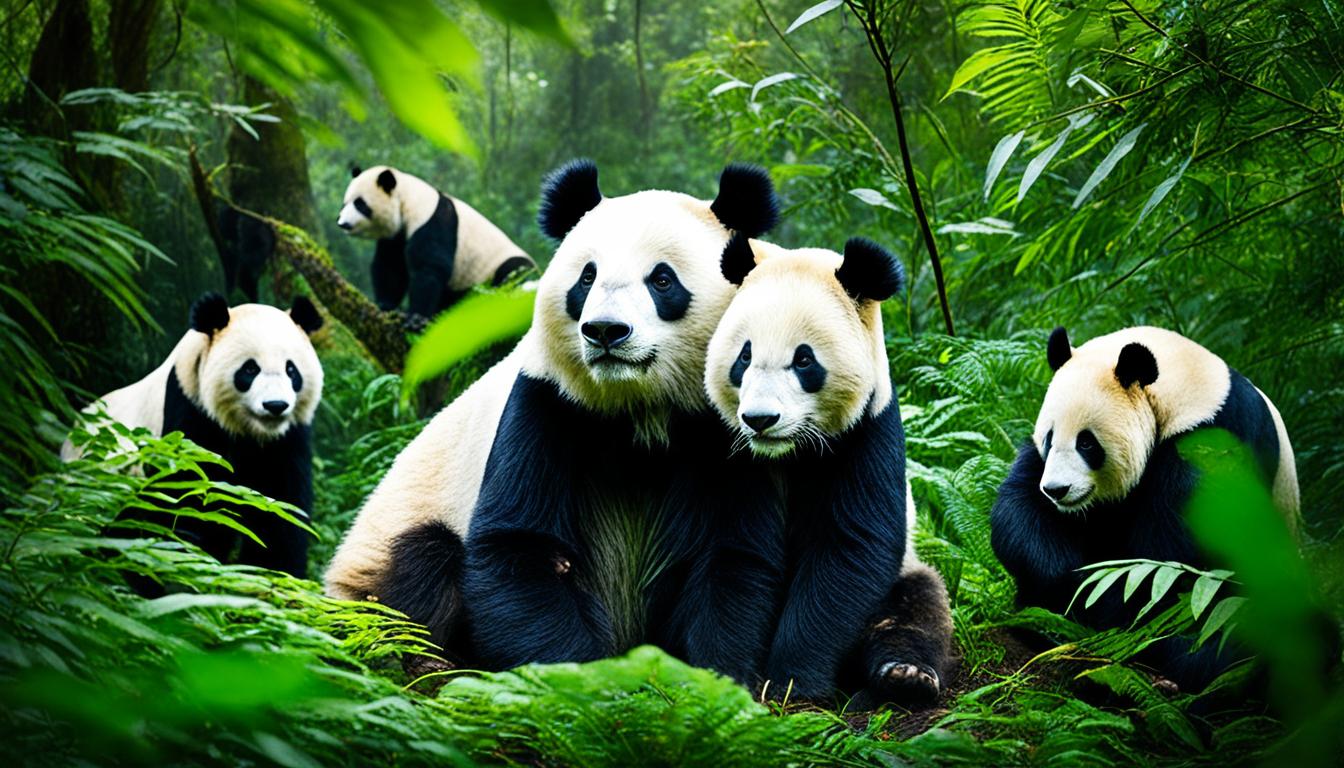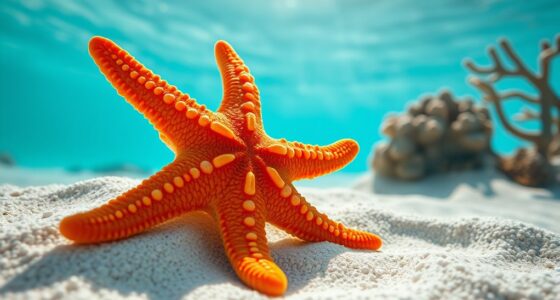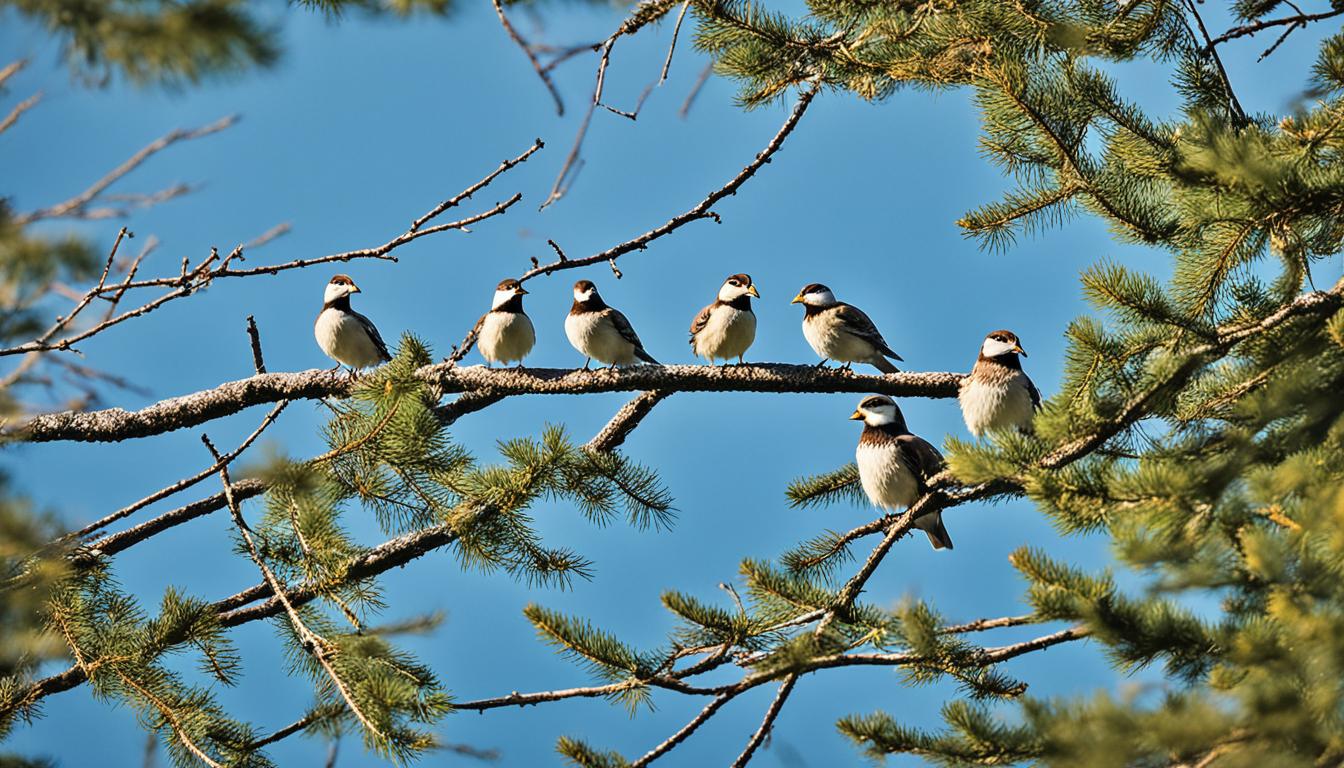Were you aware that the rate of extinction of species has vastly accelerated, placing us in the midst of the planet’s sixth mass extinction event? This alarming reality necessitates immediate action to safeguard endangered animal species and conserve biodiversity. As conscientious caretakers of our planet, it is incumbent upon us to protect these species and guarantee a healthier and more secure future for ecosystems and humanity.
Key Takeaways:
- Protecting endangered animal species is not just an ethical obligation but a necessity for the health of our planet
- The extinction rate of species has significantly increased, leading to the sixth mass extinction
- Preserving endangered species is crucial for maintaining biodiversity and ensuring the stability of ecosystems
- Our duty to protect endangered species extends beyond our own interests and encompasses the health and stability of the planet
- By taking collective action, we can make a significant difference in preserving endangered animal species and their habitats
Why Should We Protect Endangered Animals?
Endangered species play a vital role in maintaining biodiversity. Each species contributes to the intricate balance of nature, ensuring the health and stability of ecosystems. When species become endangered or go extinct, it disrupts this balance and can have far-reaching effects on other species. Additionally, endangered species can serve as indicators of environmental health, highlighting underlying issues such as habitat destruction, pollution, and climate change. By protecting endangered animals, we safeguard the wellbeing of entire ecosystems.
Endangered animals are not just individual beings struggling for survival; they are integral components of a larger tapestry that sustains the planet. The interconnectedness of different species forms a delicate web of life, where each species plays a unique role. The loss of one species can have cascading effects on others, disrupting the finely tuned balance that has developed over millions of years.
By protecting endangered animals, we are not only safeguarding their future but also preserving the biodiversity and environmental health of our planet.
Conserving endangered species is not solely about protecting individual animals or plants—it is about protecting the intricate complex of relationships and interactions that contribute to a healthy and functioning ecosystem. These ecosystems provide us with clean air, fresh water, fertile soil, and vital resources for our survival and well-being. When we protect endangered animals, we are also protecting ourselves and future generations.
Furthermore, endangered species act as environmental indicators, giving us valuable insights into the health of ecosystems. Their decline or disappearance can signal the presence of deeper underlying issues such as habitat destruction, pollution, or climate change. By paying attention to the plight of endangered animals, we can address the root causes and take action to restore balance and ensure the long-term sustainability of our environment.
Protecting endangered animals is not just a duty; it is an investment in the future of our planet and the generations to come.
The Impact of Endangered Species on Climate Change
Biodiversity plays a crucial role in the fight against climate change. Preserving endangered species is not only essential for the well-being of these individual species but also for the health of our planet as a whole. Biodiverse ecosystems contribute to regulating temperatures, sequestering carbon dioxide, and support the resilience of ecosystems in the face of climate impacts.
When biodiversity is reduced due to habitat destruction or species loss, ecosystems become more vulnerable and compromised. The loss of key species disrupts the natural functions that contribute to climate adaptation and mitigation. Protecting endangered species is, therefore, vital to mitigating climate change and preserving the natural functions that maintain the balance of our ecosystems.
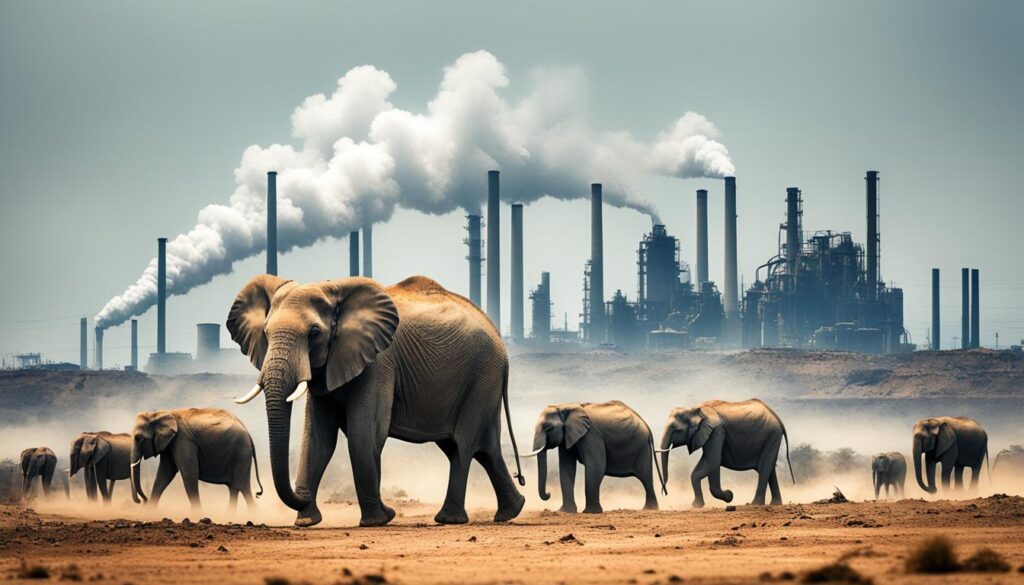
| Natural Functions of Endangered Species in Climate Change Mitigation | Effects of Biodiversity Loss on Climate Change |
|---|---|
| Regulation of temperatures | Decreased resilience to climate impacts |
| Sequestration of carbon dioxide | Reduced carbon storage capacity |
| Enhanced ecosystem resilience | Inability to adapt to changing climate conditions |
| Support for climate adaptation | Disruption of natural climate regulation |
The Role of Endangered Species as Ecosystem Engineers
Some endangered animals serve as “ecosystem engineers,” actively contributing to the protection and maintenance of their environments. Through their feeding behaviors and other ecological roles, these species play a crucial role in creating balance within their habitats and sustaining the intricate food webs that support diverse ecosystems.
For instance, sharks, despite being vulnerable themselves, act as regulators of prey populations in marine ecosystems. Their presence helps maintain the delicate balance of the food webs, preventing the overgrowth of certain prey species and promoting biodiversity.
Elephants, another example of ecosystem engineers, play a vital role in dispersing seeds as they move across their habitats. By consuming fruits and excreting seeds in different locations, elephants contribute to the creation of new habitats and the growth of diverse plant species.
“Sharks and elephants are just a few examples of endangered species that act as ecosystem engineers. By understanding their ecological roles and safeguarding their populations, we can preserve the delicate balance of our habitats and ensure the sustainability of our ecosystems.”
Seals are also instrumental in maintaining balance within marine food webs. They serve as both predators and prey, occupying a unique position in the ecological chain. Their presence contributes to nutrient cycling, as they consume marine organisms and excrete waste on coastal habitats, fertilizing the surrounding environment.
The conservation of these endangered species is of utmost importance in sustaining ecosystems and preserving the delicate balance that supports a wide array of life forms. By protecting the ecosystem engineers, we safeguard habitats, uphold the intricate food webs that maintain biodiversity, and ensure the long-term resilience of our planet.
The Cultural Significance of Endangered Species
Endangered species are not just essential for ecological reasons; they also hold tremendous cultural and traditional significance for many communities around the world. The preservation of these species is vital for safeguarding cultural heritage and traditions that have been deeply intertwined with nature for centuries.
One example of such cultural significance can be seen in the beliefs of the Mazahua people in Mexico. They consider the Monarch butterflies, an endangered species, as the spirits of their departed loved ones. These beautiful creatures play a significant role in their spiritual rituals, symbolizing the connection between life and death.
“The Monarch butterflies are our ancestors, returning to guide us onto our spiritual journey, reminding us of our connection to nature and the cycle of life,” says Maria Hernandez, a Mazahua elder.
Additionally, the African savannah elephants have deep cultural connections with indigenous communities across Africa. These majestic creatures represent wisdom, strength, and a profound connection to their people. They are often central figures in traditional stories, dances, and ceremonies, playing a vital role in preserving cultural identity and passing down ancestral knowledge from one generation to another.
By protecting endangered species like the Monarch butterflies and African savannah elephants, we not only ensure the continuity of valued cultural traditions but also foster a deeper appreciation for the rich biodiversity that surrounds us.
The Cultural Significance: A Source of Unity and Pride
Endangered species are not only biological treasures but also symbols of cultural unity and pride. They unite communities, empowering them to protect their customs, rituals, and shared heritage rooted in the natural world.
Moreover, the conservation of these species provides an opportunity for intergenerational exchange, with elders sharing their traditional knowledge and younger generations gaining a deeper understanding of the connection between culture and the environment.
We must recognize that the cultural significance of endangered species extends beyond their ecological value. Preserving these species is an essential part of preserving cultural diversity and ensuring the passing on of tangible and intangible cultural heritage to future generations.
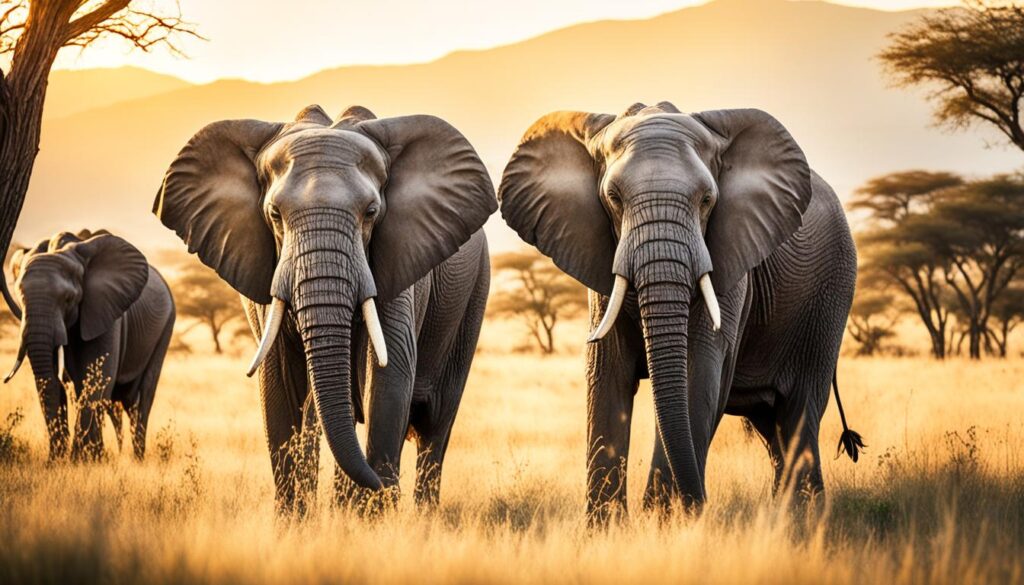
| Endangered Species | Cultural Significance |
|---|---|
| Monarch butterflies | Viewed as the spirits of the dead by the Mazahua people in Mexico |
| African savannah elephants | Deep cultural connections and symbols of wisdom and connection to indigenous groups |
Human Activities as a Threat to Endangered Species
The sixth mass extinction event is primarily caused by human activities such as habitat destruction, deforestation, pollution, overexploitation, introduction of invasive species, and climate change. These activities have led to widespread biodiversity loss and the decline or extinction of numerous species. It is our responsibility to protect endangered species and the environments they inhabit through behavioral changes, policy changes, and urgent international action.
“The ongoing destruction of habitats and overexploitation of natural resources are threatening the delicate balance of ecosystems and pushing many species to the brink of extinction. It is crucial that we recognize the impact of our actions and work towards sustainable solutions to mitigate the threats faced by endangered species.” – Dr. Rachel Johnson, Wildlife Conservation Scientist
The Impact of Habitat Destruction
Habitat destruction is one of the leading threats to endangered species. As human populations grow and expand, natural habitats are being cleared for agriculture, urban development, and infrastructure projects. This destruction disrupts ecosystems and displaces species, often leading to their decline or extinction. Without intact and diverse habitats, endangered species struggle to find food, shelter, and breeding grounds, further impacting their survival.
Overexploitation and its Consequences
Overexploitation, which includes activities such as hunting, fishing, and illegal trade, poses a significant threat to endangered species. When species are overharvested or poached beyond their reproductive capacity, their populations decline rapidly. Species like elephants, rhinos, and tigers are particularly vulnerable to overexploitation for their ivory, horns, and skins. This unsustainable demand threatens their survival and disrupts ecosystems.
The Role of Climate Change
Climate change, largely caused by human activities, is a major threat to endangered species. Rising temperatures, changing weather patterns, and sea-level rise directly impact the habitats and food sources of many species. From coral bleaching that devastates delicate marine ecosystems to the loss of polar bear habitats due to melting ice, climate change poses a significant risk to biodiversity. Urgent action is needed to reduce greenhouse gas emissions and mitigate the effects of climate change.
The Importance of Awareness and Education
Increasing awareness about the consequences of human activities on endangered species is vital. By educating ourselves and others, we can promote responsible behavior, sustainable practices, and conservation efforts. Engaging in eco-friendly practices, supporting local initiatives, and advocating for stronger environmental policies are essential steps towards protecting endangered species and mitigating the threats they face.
| Human Activities | Impact on Endangered Species |
|---|---|
| Habitat destruction | Displacement and decline |
| Deforestation | Loss of key habitats, disruption of ecosystems |
| Pollution | Contamination of water, air, and soil |
| Overexploitation | Population decline, endangerment, and extinction |
| Introduction of invasive species | Competition and predation on native species |
| Climate change | Habitat loss, disrupted ecosystems, increased extinction risk |
Protecting endangered species requires a collective effort to address the root causes of their decline. It is our duty to prioritize conservation, adopt sustainable practices, and advocate for stronger environmental policies to ensure a brighter future for both endangered species and our planet as a whole.
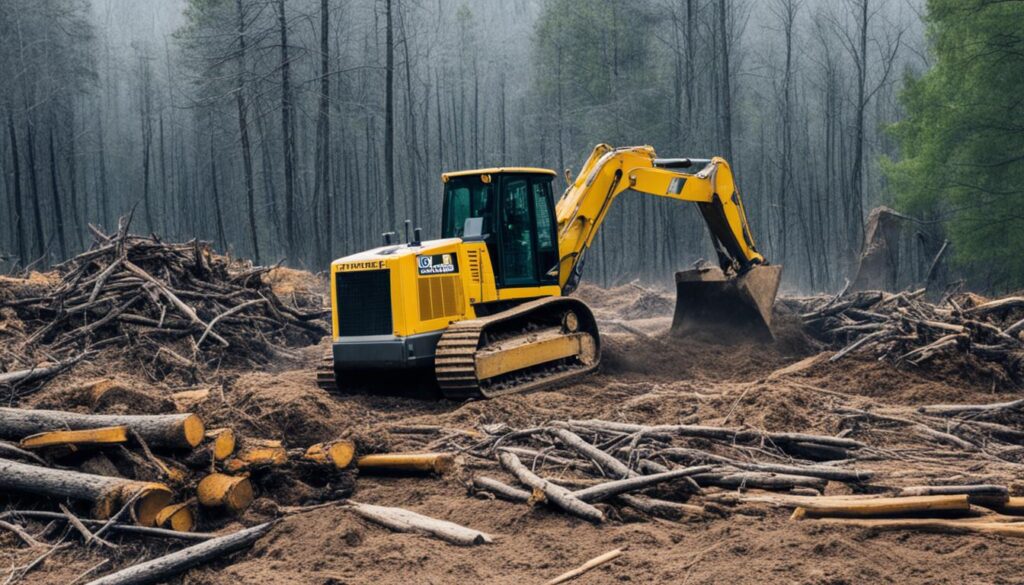
Taking Action to Protect Endangered Species
As conscious stewards of our environment, we have the power to make a difference in protecting endangered species and preserving biodiversity. Every small action we take collectively contributes to the larger cause of safeguarding these vulnerable animals and their habitats. Here are several impactful ways we can actively protect endangered species:
- Rewilding Gardens: By creating wildlife-friendly gardens, we can provide essential habitats for pollinators and other endangered species. Planting native flowers, shrubs, and trees, and avoiding the use of pesticides, we help create sanctuaries that support biodiversity.
- Participating in Beach Cleanups: Joining community beach cleanup initiatives is an effective way to protect marine species and their habitats. By cleaning up our beaches and coastal areas, we prevent harmful debris from polluting the ocean and endangering wildlife.
- Choosing Eco-Friendly Products: Opting for eco-friendly cleaning products, sustainable household items, and responsibly sourced materials minimizes our ecological footprint. Supporting brands that prioritize environmentally friendly practices helps protect endangered species and their habitats.
- Reducing Meat Consumption: Embracing meat-free dinners or incorporating more plant-based meals into our diet significantly reduces the demand for animal agriculture. This conscious choice helps mitigate habitat destruction, deforestation, and greenhouse gas emissions associated with livestock production, ultimately protecting endangered species.
- Supporting Wildlife Conservation Experts: Contributing to reputable wildlife conservation organizations and supporting the dedicated experts in the field allows us to help protect endangered species more effectively. Financial contributions, volunteering, or participating in awareness campaigns assist in funding essential research, conservation programs, and advocacy efforts.
Our collective efforts to protect endangered species can have a significant impact on preserving biodiversity and ensuring a sustainable future for our planet. By taking these actions, we actively contribute to the conservation efforts aimed at safeguarding these remarkable creatures and the delicate ecosystems they inhabit.
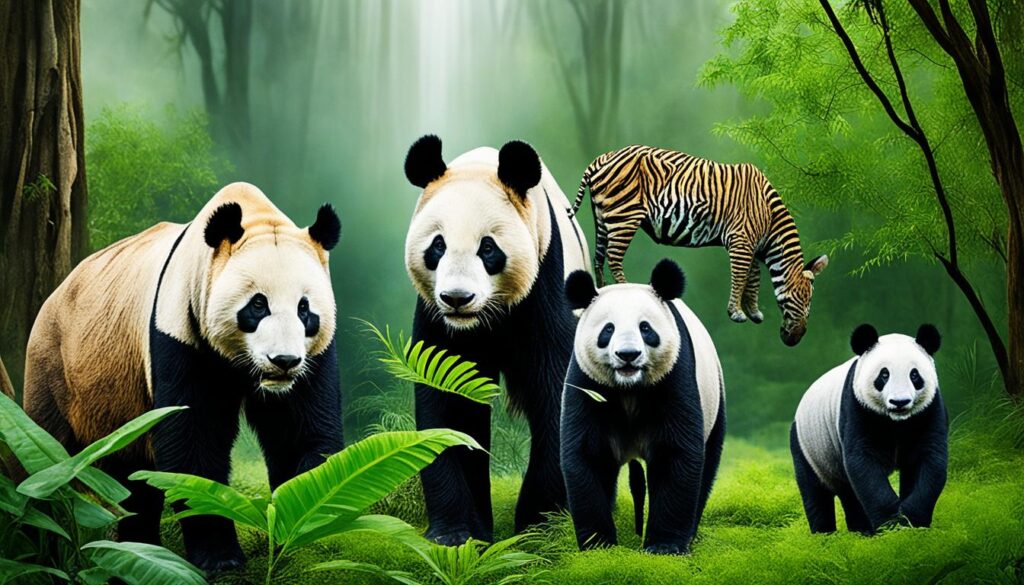
Quote:
“The smallest act of kindness towards an animal is a step towards a better world for all living beings.” – Unknown
| Action | Impact |
|---|---|
| Rewilding Gardens | Provides essential habitats for pollinators and endangered species. |
| Participating in Beach Cleanups | Protects marine species and prevents pollution of coastal habitats. |
| Choosing Eco-Friendly Products | Minimizes environmental impact and supports sustainable practices. |
| Reducing Meat Consumption | Helps mitigate habitat destruction and greenhouse gas emissions. |
| Supporting Wildlife Conservation Experts | Provides valuable resources for research, programs, and advocacy. |
The Importance of Captive Breeding in Species Conservation
Captive breeding programs play a crucial role in the conservation of endangered species. These programs are designed to maintain and revive populations that have lost their natural habitats due to factors such as habitat loss and degradation, climate change, and human activities.
Through captive breeding, animals can be bred in controlled environments, ensuring their survival and preventing their complete extinction. This approach provides a safety net for species at risk and allows for the possibility of reintroducing them to their natural habitats when suitable conditions are restored.
It is important to note that while captive breeding programs offer temporary solutions, they are not a replacement for addressing the root causes of species decline. The continued loss of natural habitats remains a significant threat to endangered species, and comprehensive conservation efforts must tackle issues such as habitat loss, illegal wildlife trade, and unsustainable human practices.
Captive breeding programs are most effective when integrated with wider conservation strategies that prioritize habitat protection and restoration. By addressing the underlying factors contributing to species decline, we can work towards long-term species recovery and the preservation of biodiversity.
The Benefits of Captive Breeding
Captive breeding programs provide several benefits for the conservation of endangered species:
- Population Preservation: By breeding animals in captivity, we can maintain populations and prevent species from going extinct.
- Genetic Diversity: Through careful breeding management, captive programs can help preserve genetic diversity within species, reducing the risk of inbreeding and maintaining healthy populations.
- Education and Research: Captive breeding programs offer opportunities for scientific research and public education, enabling us to learn more about these species and raise awareness about their conservation needs.
It is crucial to prioritize the well-being and ethical treatment of animals involved in captive breeding programs. Stringent regulations and guidelines are in place to ensure the proper care, enrichment, and welfare of captive individuals.
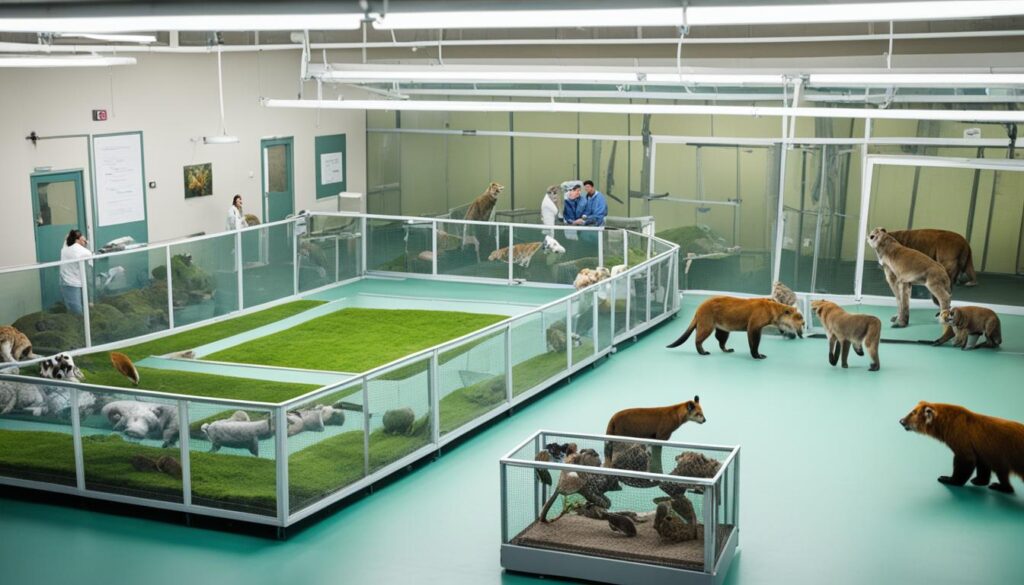
Case Study: Arabian Oryx Conservation
One notable success story of captive breeding is the conservation of the Arabian oryx, a species once classified as extinct in the wild. Through coordinated international efforts and captive breeding programs, the Arabian oryx population has been successfully restored in its native range.
| Year | Wild Population | Captive Population |
|---|---|---|
| 1972 | 0 | 19 |
| 2021 | 2,000+ | Over 7,000 |
“The captive breeding efforts for the Arabian oryx demonstrate that with proper conservation strategies and international collaboration, we can reverse the fortunes of endangered species and restore their populations to healthy levels in the wild.” – Dr. Maria Rodriguez, Wildlife Conservation Society
The Need for International Collaboration in Species Conservation
Protecting endangered species requires international collaboration and cooperation. While international organizations like the International Union for Conservation of Nature (IUCN) play a critical role in bringing attention to species conservation, the real conservation work happens at the national and local levels. It involves dialogue, political will, and implementing effective conservation strategies. By working together, we can address the global threats to biodiversity and ensure the long-term survival of endangered species.
The challenges faced by endangered species transcend borders, requiring a united effort from countries around the world. International collaboration allows us to combine our knowledge, resources, and expertise to implement comprehensive conservation measures. By sharing best practices, research findings, and technological advancements, we can develop more effective strategies for species conservation and environmental protection.
Key Benefits of International Collaboration
- Enhanced Biodiversity Protection: International collaboration enables the conservation of endangered species across their entire range. By coordinating efforts, we can conserve habitats, protect migratory pathways, and implement initiatives that span multiple countries. This integrated approach ensures the long-term viability of species and fosters healthy ecosystems.
- Shared Responsibility: Endangered species are not constrained by national borders. Their survival depends on the collective actions of diverse countries and stakeholders. By fostering international collaboration, we acknowledge our shared responsibility and work collectively towards ensuring the continued existence of endangered species.
- Knowledge Exchange and Capacity Building: Collaboration provides an opportunity for countries to share knowledge, scientific research, and management strategies. This exchange of information facilitates capacity building, allowing countries to enhance their conservation initiatives through shared expertise and learn from successful conservation programs around the world.
- Policy Harmonization: International collaboration helps align conservation policies and frameworks across nations. Through dialogue and negotiation, countries can develop common goals and standards, creating a cohesive approach to species conservation and environmental protection.
- Funding Opportunities: Collaboration opens avenues for greater funding opportunities for species conservation. International partnerships can leverage financial resources from multiple sources, including government grants, philanthropic organizations, and public-private partnerships. This increased funding enables the implementation of larger-scale conservation projects and the development of sustainable solutions.
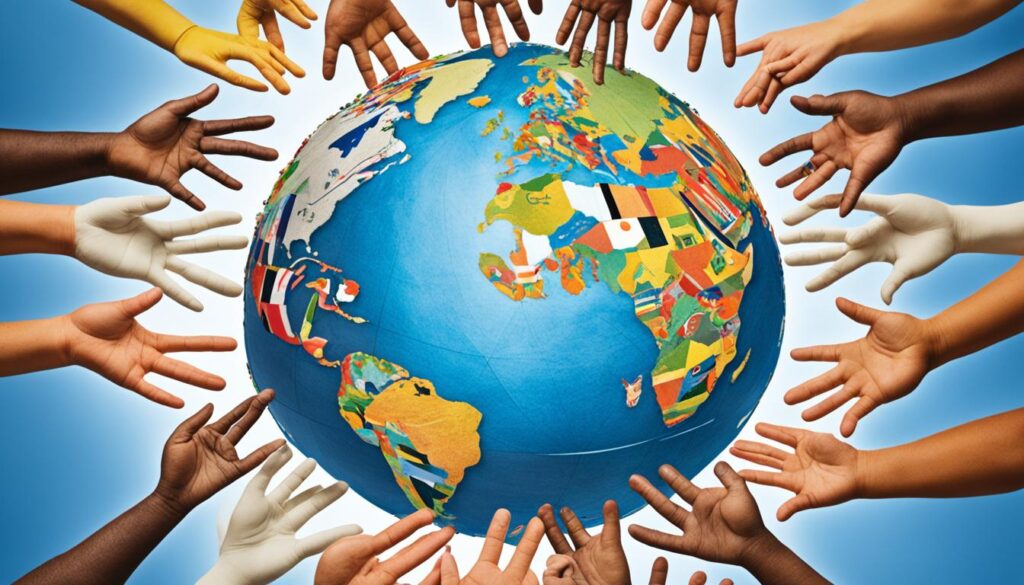
International collaboration is essential in addressing the complex and interconnected challenges faced by endangered species. It allows us to pool our resources, knowledge, and efforts, maximizing the impact of conservation initiatives. By working together, we can preserve biodiversity, protect ecosystems, and secure a sustainable future for both current and future generations.
The Uncertain Future of Endangered Species
Despite some conservation efforts yielding positive results, the future of endangered species remains uncertain. The relentless forces of habitat loss, climate change, and other detrimental human activities continue to threaten these vulnerable animals. As a result, the risk of extinction looms large, casting a shadow over their survival.
This uncertain future stems from the widespread habitat loss experienced by endangered species. Human activities, such as deforestation, urbanization, and industrialization, have significantly reduced the available habitats for many species. Without suitable habitats, these animals struggle to find food, reproduce, and thrive in their natural environments.
The loss of biodiversity also contributes to the endangered species’ precarious situation. Each species plays a unique role in maintaining the delicate balance of ecosystems. When a species disappears, it disrupts the intricate web of interactions within the ecosystem, potentially leading to cascading effects throughout the food chain and ecosystem function.
Furthermore, the looming threat of climate change exacerbates the challenges faced by endangered species. Rising temperatures, changing weather patterns, and altered habitats directly impact their ability to survive and adapt. The uncertainty of these environmental changes intensifies the risk of extinction for species already on the brink.
Urgent action is crucial to protect and conserve endangered species. Raising awareness about the threats they face is essential in fostering a collective sense of responsibility and inspiring action. Implementing stringent conservation measures, such as habitat restoration, protected areas, and sustainable resource management, can help mitigate habitat loss and provide a lifeline for these species.
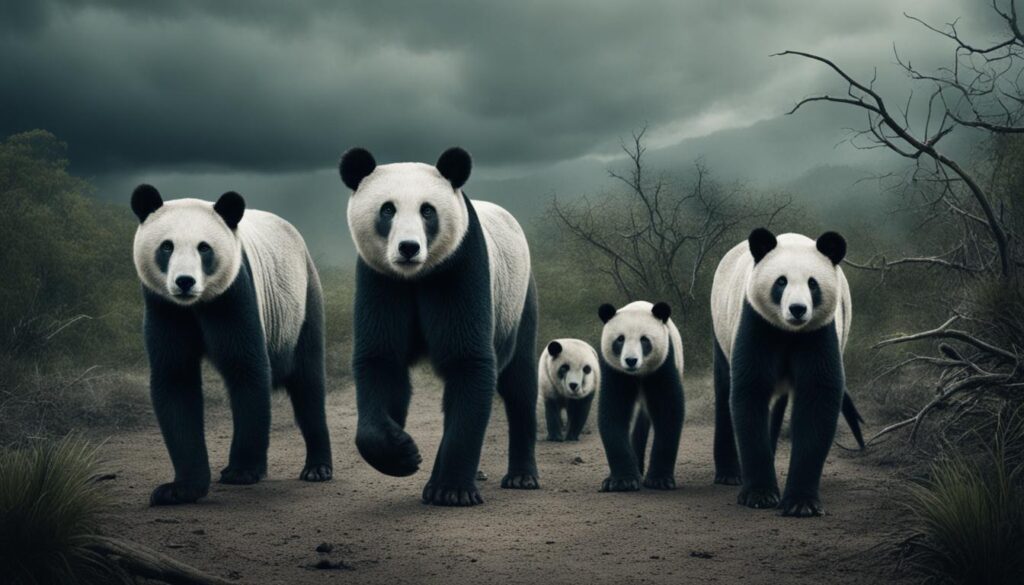
Preserving and restoring wildlife habitats is an invaluable step towards securing the future of endangered species. By safeguarding these habitats, we create safe havens where these animals can thrive, reproduce, and contribute to the overall health and resilience of ecosystems.
The Urgency of Biodiversity Conservation
Biodiversity is the web of life that sustains us all. The loss of species threatens the functionality of ecosystems and compromises our own well-being. It is our duty to protect and conserve endangered species for the sake of our planet and future generations.
Through international cooperation, strict legislation, and sustainable practices, we can address the root causes of habitat loss, reduce the impact of climate change, and minimize the extinction risk faced by endangered species.
Together, we can secure a more certain future for these remarkable creatures and safeguard the irreplaceable biodiversity that enriches our planet.
Making a Difference: How Individuals Can Help
Protecting endangered wildlife is a collective responsibility, and individuals can play an integral role in making a difference. By taking action, we can contribute to the preservation of endangered species and their habitats. Here are some ways you can help:
- Volunteer: Get involved with local zoos or conservation organizations. Volunteer opportunities may include assisting in animal care, participating in habitat restoration projects, or educating the public about endangered species.
- Donate: Support reputable wildlife conservation efforts with financial contributions. Your donations can help fund vital research, habitat protection initiatives, and conservation projects aimed at safeguarding endangered wildlife.
- Raise Awareness: Participate in awareness campaigns to educate others about the importance of protecting endangered species. Share information on social media, organize community events, or give presentations at schools and organizations to spread the word.
- Support Environmental Policies: Advocate for policies that prioritize environmental protection and conservation. Stay informed about local and national initiatives, contact legislators, and join organizations working towards sustainable practices and wildlife conservation.
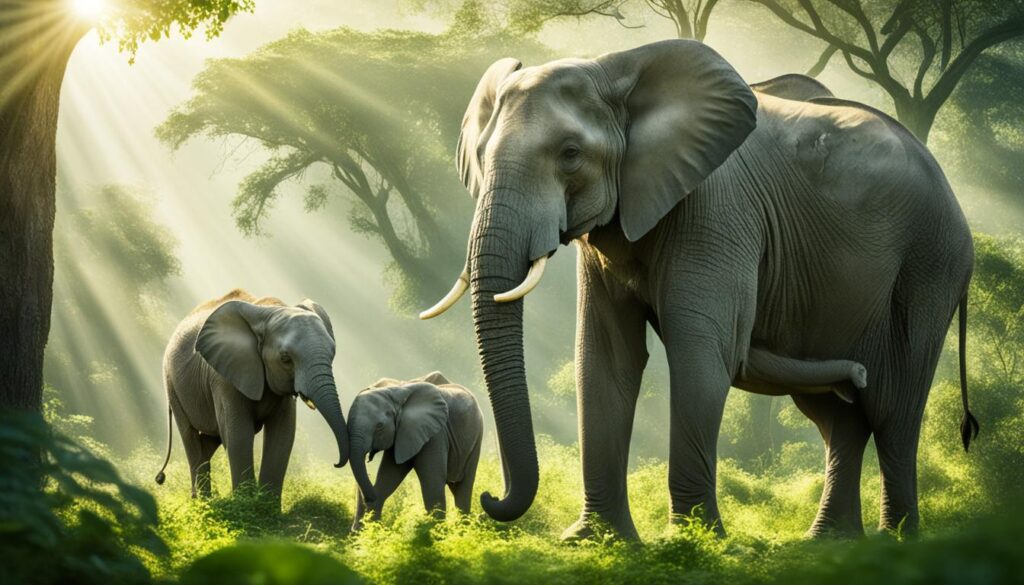
The Ethical Duty to Protect Endangered Species
The preservation of endangered species is not merely a choice; it is an ethical duty that stems from our understanding of the intrinsic value of all living beings and the interconnectedness of ecosystems. Endangered species hold inherent worth and contribute to the delicate balance of biodiversity, which is essential for maintaining the health and stability of our planet.
Our duty to protect endangered species extends beyond human interests and encompasses the preservation of the natural world as a whole. By conserving these species and their habitats, we ensure the continuation of vital ecological processes and the well-being of countless other organisms that rely on them.
“The ethical duty to protect endangered species is grounded in our recognition that every living being deserves respect and has a right to exist.”
The Intrinsic Value of Endangered Species
Endangered species possess inherent value, independent of their utilitarian or economic significance to humans. Each species represents a unique evolutionary heritage, contributing to the richness and complexity of life on Earth. When a species teeters on the brink of extinction, a vital part of our planet’s natural history and diversity is at risk of being forever lost.
The Preservation of Biodiversity
Protecting endangered species is essential for preserving biodiversity, which is the foundation of healthy ecosystems. Biodiversity increases ecosystem resilience, enhances ecosystem services, and promotes stability in the face of environmental changes. By safeguarding endangered species, we safeguard the intricate web of life that supports us all.
The Conservation of Ecosystems
Endangered species serve as integral components of ecosystems, contributing to their proper functioning and stability. Each species plays a unique role in maintaining ecological balance, such as pollination, seed dispersal, and predator-prey relationships. When these species decline or disappear, the delicate equilibrium of ecosystems is disrupted, leading to cascading effects on other species and ecological processes. Conserving endangered species ensures the preservation of healthy and functioning ecosystems.
The Maintenance of Planet’s Health and Stability
Endangered species, as indicators of ecosystem health, serve as a barometer for the overall well-being of our planet. Their decline or disappearance often signifies underlying issues such as habitat destruction, pollution, and climate change. By protecting endangered species, we address these root causes and strive toward a more sustainable future for both the natural world and ourselves.
| Benefits of Protecting Endangered Species | Threats to Consider |
|---|---|
| Preservation of biodiversity | Habitat destruction |
| Maintenance of ecosystem balance | Climate change |
| Promotion of ecological resilience | Overexploitation |
| Indication of environmental health | Invasive species |
The preservation and conservation of endangered species should be viewed as our moral obligation—an ethical duty to protect the remarkable diversity of life on Earth and safeguard the future of our planet.
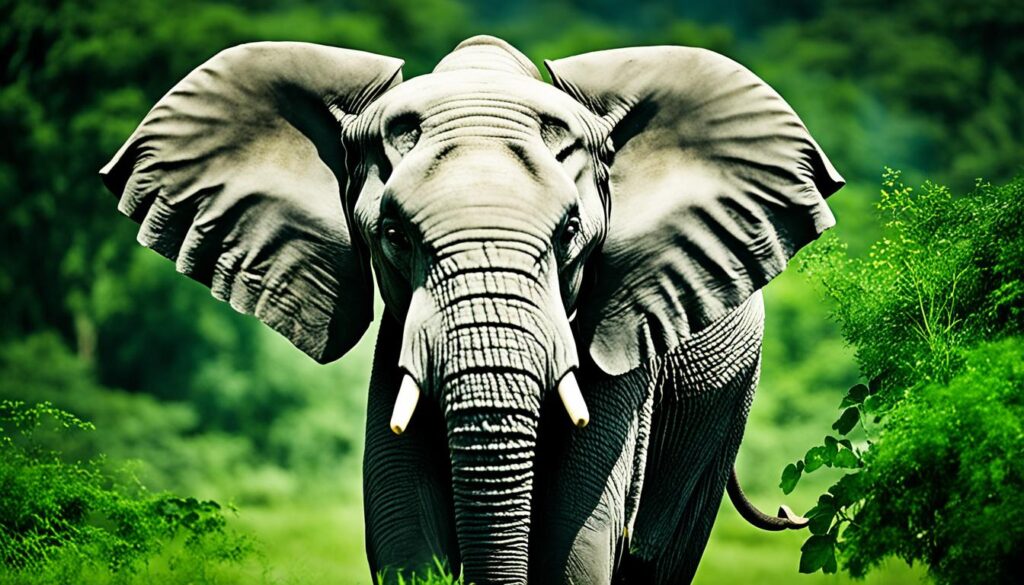
The Role of Science and Research in Species Conservation
Science and research are integral components of successful species conservation efforts. Through rigorous scientific studies, we gain a deeper understanding of the threats that endangered species face, enabling us to develop effective conservation strategies and monitor the progress of our conservation efforts.
Research plays a pivotal role in informing policy decisions related to species conservation. By examining data and empirical evidence, policymakers can make well-informed choices that prioritize the protection and preservation of endangered species. Scientific research also helps raise awareness among the general public about the urgent need for species conservation.
Furthermore, research acts as a catalyst for mobilizing resources and support for species conservation. When we uncover new findings and discoveries through scientific studies, it creates a sense of urgency and inspires individuals, organizations, and governments to take action in protecting endangered species.
“Scientific research is essential in understanding the complex dynamics of ecosystems and the impacts of human activities on endangered species. It provides the foundation for designing effective conservation programs and policies, ensuring a sustainable future for biodiversity.”
Collaboration is key in leveraging the power of science and research to conserve endangered species. Scientists, conservationists, and policymakers must work hand in hand, sharing expertise and knowledge to achieve meaningful conservation outcomes. Through collaboration, we can bridge the gap between research and implementation, translating scientific findings into practical conservation measures that have a positive impact on endangered species.
The Role of Science and Research in Species Conservation:
| Scientific Research | Conservation Strategies | Monitoring Success |
|---|---|---|
| Provides understanding of threats to endangered species | Develops effective conservation strategies | Evaluates the progress of conservation efforts |
| Informs policy decisions | Inspires public awareness and support | Mobilizes resources for conservation |
| Facilitates collaboration between scientists, conservationists, and policymakers | Translates research findings into practical measures | Achieves meaningful conservation outcomes |
By harnessing the power of science and research, we can drive informed decision-making, raise awareness, and implement effective conservation strategies. Together, let us prioritize the role of science in species conservation and ensure a sustainable future for our precious biodiversity.
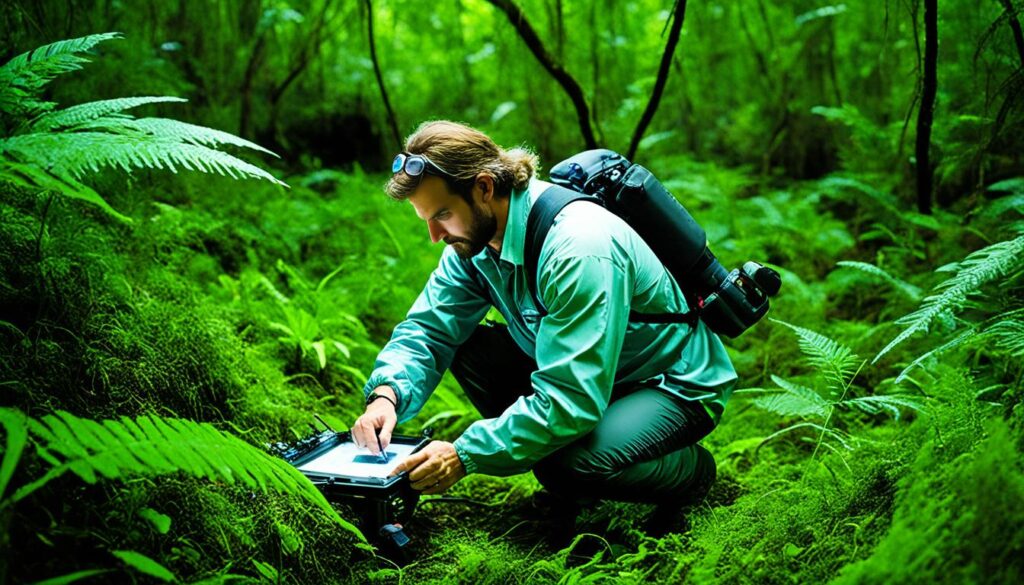
Conclusion
Protecting endangered animal species is not just a moral duty but a necessity for the health and well-being of our planet. The conservation and preservation of biodiversity ensure the long-term survival of ecosystems and the sustainability of our planet.
By taking individual and collective action, we can make a significant difference in protecting endangered species and ensuring a brighter future for generations to come. It is our duty to act now and prioritize the preservation of endangered animal species.
Together, we can create a world where endangered species thrive and contribute to the rich tapestry of life on Earth. Let us join forces, advocate for change, and actively work towards the protection and preservation of these magnificent creatures. The time to act is now.
FAQ
Why is protecting endangered animals important?
How do endangered species impact climate change?
What is the role of endangered species as ecosystem engineers?
Do endangered species hold cultural significance?
What are the human activities threatening endangered species?
How can individuals help protect endangered species?
How does captive breeding help endangered species conservation?
Why is international collaboration important in species conservation?
What is the future of endangered species?
How can individuals make a difference in protecting endangered wildlife?
Why is there an ethical duty to protect endangered species?
What is the role of science and research in species conservation?
How Can Protecting Endangered Species Relate to Keeping Pets Safe in Hot Weather?
Protecting endangered species and keeping pets safe in hot weather go hand in hand. By following hot weather pet safety tips, such as providing shade and water, we can protect our pets from heat-related illnesses. Conserving wildlife habitats also ensures the survival of diverse species, creating a balanced ecosystem for all creatures.
